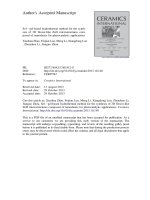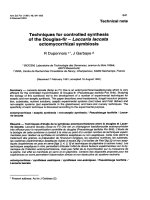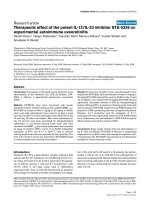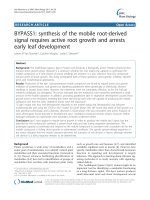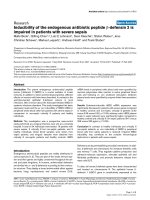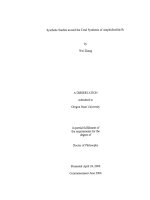Total synthesis of the potent antibiotic platensimycin
Bạn đang xem bản rút gọn của tài liệu. Xem và tải ngay bản đầy đủ của tài liệu tại đây (7.12 MB, 421 trang )
TOTAL SYNTHESIS OF THE POTENT
ANTIBIOTIC PLATENSIMYCIN
EEY TZE CHIANG STANLEY
NATIONAL UNIVERSITY OF SINGAPORE
2011
TOTAL SYNTHESIS OF THE POTENT
ANTIBIOTIC PLATENSIMYCIN
EEY TZE CHIANG STANLEY
(B.Sc.(Hons.), NUS
A THESIS SUBMITTED FOR THE DEGREE OF
DOCTOR OF PHILOSOPHY
DEPARTMENT OF CHEMISTRY
NATIONAL UNIVERSITY OF SINGAPORE
2011
i
To my mum and my wife Alicia
ii
ACKNOWLEDGEMENTS
I joined the Lear-group in 2005 as an undergraduate, and I was one of the
few pioneer members who have stayed and grew with the group. This is the
place where I was first introduced to synthetic natural product chemistry, and
my interest in this field has deepened over the years. I could still remember the
grueling first time I met up with Dr. Lear, and he overwhelmed me with his
jargon of name reactions in organic chemistry. He has then been a considerable
figure who has greatly influenced me over the years. The phrase “…not for the
weak-hearted…” was an advice from Dr. Lear to students applying for his total
synthesis projects. Indeed, the completion of this project did not come easy,
and I would not have succeeded without the help from several people.
I am sincerely grateful to my supervisor Dr. Martin J. Lear who has given
me much valuable advice and encouragement throughout my studies. He has
always been patient and understanding in giving me time to surmount the
difficulties I encountered over the course of my research and personal events. I
would also like to thank him for the confidence and freedom he has given me
to exercise my creativity and determination in carrying out my research
independently. Finally, I could not thank him more for his thoughtful efforts to
financially support me as a research assistant in the group during the final year
of my Ph.D. study, which also happened to be my toughest period.
I would like to express this gratitude to ALL the past and present Lear-
group members for their advice and assistance shown to me over the years with
special mentioning – Dr. Santosh Kumar, Mr. Shibaji Ghosh, and Mr. Eugene
Yang whom have been very generous with their support and friendship. Not
forgetting Dr. Patil Basanagoud, Dr. Bastien Reux, Dr. Oliver Simon, Dr. Miao
iii
Ru, Dr. Song Hongyan, Dr. Ngai Mun-Hong, and Mr. Sandip Pasari whose
friendship to me preserved my sanity in the laboratory with their lively
companionship and helpful discussions. I would also like to thank my
undergraduate students – Miss Toh Qiaoyan, Mr. Jason Tan, Mr. Benjamin
Tan, Mrs. Goh-Huang Xinhui, and Miss Tang Shiqing, as I have truly learned
and benefitted from every one of them.
I want to express my special thanks to Prof. Tan C. H. for his timely
concern and encouragement during my Ph.D. study. My earnest appreciation
extends to the past and present CMMAC staff, especially Madam Han Yanhui,
Mr. Wong Chee Ping, and Madam Lai Hui Ngee for their expertise and kind
assistance in the characterization of the compounds in this thesis. I would also
like to thank a group of great support staff – Miss Suriawati Binte Saad,
Madam Irene Teo, Madam Lim Nyoon Keow, and Mr. Sim Hang Whatt for
their wonderful administrative and technical assistance over the years.
I owe a very special and big thank you to my parents whom have made me
what I am today with their unrelenting devotion to my education and
unconditional support of my personal goals. My mum, in particular, has only
little knowledge about my Ph.D. work, but she has always kept her confidence
in me, and showed me her greatest support by keeping me healthy and strong
throughout my studies.
Finally, I would like to thank my wife, Alicia Lock who is also my best
friend, from the bottom of my heart for her unwavering patience, confidence,
encouragement, and love. Her timely support and sacrifice over the past eight
years have been my source of courage and motivation every day.
iv
TABLE OF CONTENTS
TABLE OF CONTENTS iv
ABSTRACT ix
LIST OF TABLES xi
LIST OF FIGURES xiv
LIST OF SCHEMES xvii
LIST OF SPECTRA xxiii
LIST OF ABBREVIATIONS xxv
Chapter 1: An Introduction to Platensimycin
1
1.1 Background of Antibacterial Resistance 2
1.2 Discovery of Platensimycin 5
1.3 Unique Mode of Antibacterial Action 7
1.4 Biosynthesis of Platensimycin 10
1.5 Nicolaou’s Syntheses of Platensimycin 13
1.6 Total & Formal Syntheses of Platensimycin – Key Strategic Steps 19
1.7 Platensimycin Analogues 40
1.8 Conclusion 42
Chapter 2: A Dirhodium(II)-Catalyzed Carbonyl Ylide
Cycloaddition Approach to Platensimycin
44
2.1 First-Generation Retrosynthetic Analysis of (±)-Platensimycin 45
2.2
Carbonyl Ylide Cycloaddition Strategy to the Oxabicyclo[3.2.1]
47
v
Carbon Skeleton
2.3 Radical-Based Cyclization and 1,4-Addition Cascade to the
Oxatricyclic Core
52
2.4 Future Plans for the Assembly of the Oxatricyclic Compact Core 54
2.5 A Second-Generation Carbonyl Ylide Cycloaddition Approach
to the Tetracyclic Enone (-)-1-23
57
2.6 Pursuit of the Quaternary-Substituted Keto-Acid
2
-
60
via Meyers’
Bicyclic Lactam Auxiliary
59
2.7 Efforts to Prepare the
α
-Diazo-Ketone Intermediate
63
2.8 Other Methods to Prepare the
α
-Diazo-Ketone Intermediate
67
2.9 Summary 71
Appendix
1
– Experimental Details for Chapter 2 73
Chapter 3: An Oxirane Rearrangement Carbonyl Ylide
Cycloaddition Approach to Platensimycin
103
3.1 Epoxy Ketone
3
-
7
as Carbonyl Ylide Precursor
104
3.2 Photo-Induced Carbonyl Ylide Cycloaddition to the Compact
Core
106
3.3 Eun Lee’s Formal Synthesis of (-)-Platensimycin via the Carbonyl
Ylide Cycloaddition Strategy
108
3.4 Designing a Photo-Labile Precursor for the Synthesis of the
Tetracyclic Enone 1-23
109
3.5 Efforts toward a Modified Second-Generation Synthesis of the
Oxabicyclo[3.2.1] Carbon Skeleton
111
vi
3.6 Efforts to Study the Regioselectivity of the Photo-Induced
Carbonyl Ylide Cycloaddition
115
3.7 Exploration of a Lewis Acid-Promoted Carbonyl Ylide
Cycloaddition with the α,β-Epoxy-1,1-Diester 3-12
122
3.8 Summary 127
Appendix
2
– Experimental Details for Chapter 3 129
Chapter 4: Early Studies on a Friedel-Crafts Cyclization Strategy
to Platensimycin
150
4.1 Third-Generation Retrosynthetic Analysis of (±)-Platensimycin
via a Friedel-Crafts Cyclization Approach
151
4.2 Efforts to Prepare the Friedel-Crafts Precursor
4
-
3
via a
Conjugate Reduction Approach
155
4.3 Synthesis of the Friedel-Crafts Precursor
4
-
3
via a Claisen-type
[3,3]-Sigmatropic Rearrangement Approach
159
4.4 Friedel-Crafts Cyclization via Marson-type Oxocarbenium
Chemistry
165
4.5 Towards Tetracyclic Dienone
4
-
1
via Alkylative
Cyclodearomatization under Mitsunobu Activation
168
4.6 Stereoselective Preparation of the Iodo-Benzotetrahydrofurans
4-67/68
172
4.7 Deprotection Strategies for Iodo-Benzotetrahydrofurans
4-67/68
176
4.8 Application of Aryl Mesylate as Protecting Group in the 183
vii
Synthesis of the Tetracyclic Dienone
4
-
1
4.9 Optimization of Synthetic Sequence 187
4.10 SnCl
4
-Mediated Friedel-Crafts Cyclization of the Free Lactol
of Aryl Allyl Ethers 4-84/85
190
4.11 Completion of the Tetracyclic Dienone
(±)-
4
-
1
193
4.12 Summary 195
Appendix
3
– Experimental Details for Chapter 4 197
Chapter 5: An Asymmetric Total Synthesis of (-)-Platensimycin
243
5.1 Retrosynthetic Analysis of (-)-Platensimycin 245
5.2 Synthesis of the Tetracyclic Dienone (-)-
4
-
1
via SnCl
4
-Mediated
Stereoselective Friedel-Crafts Cyclization
246
5.3 Synthesis of the Tetracyclic Dienone (-)-
4
-
1
via Bromohydrin
5
-
10
249
5.4 Development of a New Catalytic Friedel-Crafts Cyclization with
Bromo-Lactol 5-11
251
5.5 Discovery of a New Bi(OTf)
3
-LiClO
4
Combination for Catalytic
Friedel-Crafts Cyclization of Tosyl-Lactol 5-3
255
5.6 TBAF-Promoted Intramolecular Alkylative Dearomatization to the
Tetracyclic Dienone 4-1
257
5.7 Conjugate Reduction of the Tetracyclic Dienone
4
-
1
260
5.8 Stereocontrolled Organocatalytic Conjugate Reduction of the
Tetracyclic Dienone 4-1
266
5.9 Synthesis of the 6-Methoxyplatensinoate Esters 272
5.10 Efforts to Deprotect the C6-Methyl Enol Ether 274
viii
5.11 Formal Synthesis of (-)-Platensimycin
280
5.12 A Michael Addition Strategy to (-)-Platensic Acid
1
-
14
282
5.13 A Concise and High-Yielding Route to the Aromatic Fragment
of (-)-Platensimycin
283
5.14 Completion of the Total Synthesis of (-)-Platensimycin 285
5.15 Future Work – Explorations into C2-Symmetry-Based
Organocatalytic 1,4-Reduction of the Tetracyclic Dienone 4-1
287
5.16 Future Work – Acyl-Transfer Method in a More Convergent
Total Synthesis Approach to (-)-Platensimycin
290
5.17 Conclusion 292
Appendix
4
– Experimental Details for Chapter 5
295
List of References
346
Appendix 5
– NMR Spectra for Selected Compounds
367
ix
ABSTRACT
The pursuit and discovery of new antibiotics that prevent bacterial spread
and growth in new ways without causing drug-resistance has met limited
success since the early 1960s. In May 2006, scientists at Merck disclosed their
finding of platensimycin, a broad-spectrum antibiotic extracted from a
Streptomyces platensis broth that originated from a soil sample in South Africa.
This natural product exerts potent Gram-positive antibacterial activity with no
cross-resistance by selectively inhibiting Type II fatty acid biosynthesis
through targeting the fatty acid condensing enzyme FabF. The confluence of
interesting biological activity and structural complexity has made
platensimycin an attractive target for chemical synthesis (Chapter 1).
Whilst encountering several dead ends and detours in our earlier carbonyl
ylide cycloaddition strategies to the unprecedented tetracyclic core of
platensimycin (Chapters 2 and 3), we eventually succeeded a new and high-
yielding enantioselective formal synthesis of this natural product (Chapters 4
and 5) from commercially available eugenol in 16 steps and 18% overall yield.
The culmination of our synthesis efforts advanced three key methods: (1) a
new Bi(OTf)
3
-LiClO
4
combination to catalyze a Marson-type, Friedel-Crafts
cyclization of an unactivated lactol with complete stereo- and regiocontrol; (2)
a facile TBAF-promoted intramolecular alkylative dearomatization without
undue silyl activation; and (3) a chemo-, regio-, and diastereoselective
conjugate reduction of a cyclic dienone, inspired by iminium-based
organocatalysis to reverse substrate steric control, and transfer hydrogenation
with Hantzsch esters.
x
The unusual aromatic domain of platensimycin was synthesized from 2-
nitroresorcinol by a unique and concise four-step sequence, with an overall
57% yield, through the development of a new Lieben-haloform condition to
directly convert aryl methyl ketones to the aryl methyl esters in a practical
fashion (Chapter 5). Upon installation of the propionate side-arm via a Michael
addition approach, the amide coupling of the C-17
tetracyclic enone acid with
the anilide unit was achieved by treatment with HATU, and a final hydrolysis
subsequently completed the total synthesis of platensimycin. The exploration
of C2-symmetrical amine-based organocatalysts to further improve the desired
chemo- and stereoselectivity of the conjugate reduction step is currently
ongoing in our laboratory.
xi
LIST OF TABLES
Chapter 1
Table 1.1
Classification of commercially available antibiotics. 4
Table 1.2
Radical-based approaches to the tetracyclic enone
1
-
23
of platensimycin
20
Table 1.3
Enantioselective approaches to the tetracyclic enone
1-23 of platensimycin
26
Table 1.4
Total and formal syntheses of (±)/(-)-platensimycin 32
Chapter 2
Table 2.1
Selective reduction of the carboxylic acid in
2
-
17
50
Chapter 3
Table 3.1
Screening of conditions to promote the carbonyl ylide
cycloaddition of the epoxy ketone 3-7
107
Table 3.2
Lewis acid activation of epoxy-1,1-diester
3
-
12
towards
a sequential carbonyl ylide formation and [3+2]
cycloaddition
124
Chapter 4
Table 4.1
Screening of conditions for the HWE olefination of the
protected vanillin 4-13/14
156
Table 4.2
Screening of substrates for the BF
3
·Et
2
O-promoted 166
xii
intramolecular Friedel-Crafts arylation reaction
Table 4.3
Conditions for the bis-debenzylation of the
benzotetrahydrofuran 4-55
169
Table 4.4
Screening of conditions for the stereoselective
iodolactonization of acid 4-62
173
Table 4.5
Debenzylation of the iodo-benzotetrahydrofurans
4
-
67/68
176
Table 4.6
Debenzylation of the iodolactones cis-
4
-
63
and trans-
4
-
51
179
Table 4.7
Screening of conditions for the intramolecular alkylative
dearomatization to tetracyclic dienone 4-1
184
Table 4.8
Optimization of conditions for the intramolecular
Friedel-Crafts arylation
191
Chapter 5
Table 5.1
Lewis acid-promoted intramolecular Friedel-Crafts
arylation of the bromo-lactol 5-11
253
Table 5.2
Bi(OTf)
3
-promoted intramolecular Friedel-Crafts
arylation of the tosyl-lactol 5-3
256
Table 5.3
Alkylative cyclodearomatization of tosyl-phenol
5
-
8
in
higher boiling solvents
258
Table 5.4
Screening of conditions for a regio-, chemo- and
stereoselective conjugate reduction of the tetracyclic
dienone (-)-4-1
262
xiii
Table 5.5
Optimization study for the conjugate reduction of
4
-
1
with TFA salts of amino acid tert-butyl esters
269
Table 5.6
Screening of conditions to cleave the C6-methoxy group
of alkyl 6-methoxyplatensinoates 5-35–5-37
275
Table 5.7
Screening of conditions to cleave the C6-methoxy group
of 6-methoxyenone 5-16 as model study
277
Table 5.8
Screening of other amine-based catalysts for the
conjugate reduction of the tetracyclic dienone (-)-4-1
289
xiv
LIST OF FIGURES
Chapter 1
Figure 1.1
Structures of penicillin (
1
-
1
), vancomycin (
1
-
2
), and
linezolid (1-3)
3
Figure 1.2
Structure of (-)-platensimycin (
1
-
4
) 5
Figure 1.3
Structures of thiolactomycin (
1
-
5
) and cerulenin (
1
-
6
) 6
Figure 1.4
Catalytic cycle of FabF in bacterial fatty acid
biosynthesis (FASII) pathway
8
Figure 1.5
A.
Crystallographic studies of platensimycin and
ecFabF(C163Q)
B. Interactions between the benzoic acid and the four
critical amino acid residues
9
Figure 1.6
Biosynthesis of platensimycin (
1
-
4
) 11
Figure 1.7
Some synthetic analogs of (-)-platensimycin 42
Chapter 2
Figure 2.1
Some totally synthetic natural products prepared via the
carbonyl ylide cycloaddition approach
47
Figure 2.2
Possible fragmentation pathways for the tetrahydrofuran
moiety in 2-4
55
Figure 2.3
A
. Proposed intermediates for an anionic-based
cyclization approach to the oxatricyclic core
B. Ring closure along C8-C13 achieved by the groups of
56
xv
Njardarson and Wright
Figure 2.4
The Padwa group study on the intramolecular carbonyl
ylide cycloaddition reaction with Rh
2
(OAc)
4
for a 1,4-
diketone substrate (2-43)
58
Figure 2.5
1D-NOE studies of the p-bromobenzoyl ester
2
-
55
in
verification of the desired C8 configuration
61
Figure 2.6
A
. Fukuyama’s preparation of 2-diazoacetophenone
with their new TsNHNHTs reagent 2-87.
B. A trial synthesis of 2-diazoacetophenone from 2-
chloroacetophenone with Fukuyama’s protocol
68
Chapter 3
Figure 3.1
Hart’s photo-induced carbonyl ylide cycloaddition
protocol of epoxy ketone 3-1
105
Figure 3.2
Eun Lee’s formal synthesis of (-)-platensimycin (
1
-
4
)
via a carbonyl ylide cycloaddition approach
109
Figure 3.3
Olefin derivatives for the regioselectivity studies of the
intramolecular carbonyl ylide cycloaddition
117
Figure 3.4
Representative examples of Johnson’s formal [4+2] and
[3+2] cycloaddition reactions of ZnCl
2
-promoted
azomethine ylides from aziridines
123
Figure 3.5
A
&
B
. Lewis acid (LA)-mediated rearrangements of
the epoxide 3-12
125
Figure 3.6
X-ray crystallographic analysis of dimer
3
-
61
126
xvi
Figure 3.7
A
. Wang’s intramolecular [3+2] cycloaddition of
cyclopropane 1,1-diester to (±)-platensimycin
B. Two types of intramolecular [3+2] cycloadditions
127
Chapter 4
Figure 4.1
Jennings’ Marson-type Friedel-Crafts cyclization
approach to the natural products (A) (+)-Bruguierol C
(4-4), (B) (±)-Brussonol (4-5) and (±)-Abrotanone (4-6)
152
Figure 4.2
Intramolecular Mitsunobu-promoted Ar-3’ alkylation
approach to (A) Natsume’s duocarmycin SA (4-7), and
(B) Boger’s duocarmyciin A (4-8)
153
Figure 4.3
Wakharkar’s synthesis of
β
,
γ
-acids (4-19) using Stobbe
condensation conditions
157
Chapter 5
Figure 5.1
Determination of the absolute configuration of tosyl-
phenol 5-8 by X-ray crystallographic analysis
248
Figure 5.2
A putative trans-iminium species of the dienone
4
-
1
with amine-based organocatalyst
266
Figure 5.3
Phenylalanine-derived trans-iminium intermediate with
4-1 further stabilized by a counter-anion hydrogen
bonding network
272
Figure 5.4
Towards platensic acid
1
-
14
via the enol forms of alkyl
6-methoxyplatensinoate esters
274
xvii
LIST OF SCHEMES
Chapter 1
Scheme 1.1
Nicolaou’s racemic synthesis of platensic acid
1
-
14
14
Scheme 1.2
Nicolaou’s completion of (±)-platensimycin 15
Scheme 1.3
Nicolaou’s formal synthesis of (-)-platensimycin via an
enantionselective enyne cycloisomerization
17
Scheme 1.4
Nicolaou’s formal synthesis of (-)-platensimycin via
Myers’ asymmetric alkylation and an oxidative
dearomatization
18
Scheme 1.5
Nicolaou’s formal synthesis of (-)-platensimycin via an
enantioselective enyne cycloisomerization for terminal
alkynes
19
Scheme 1.6
A
. Synthesis of aniline
1
-
114
from Giannis’ methyl
ester
B. Giannis’ concise synthesis of the aromatic sub-unit
(1-151) of platensimycin
38
Chapter 2
Scheme 2.1
Retrosynthetic analysis of (±)-platensimycin (
1
-
4
) 46
Scheme 2.2
Synthesis of a key oxabicyclo[3.2.1]octane intermediate 48
Scheme 2.3
Preparation of the
α
,
β
-unsaturated ketone 2-4
52
Scheme 2.4
Key radical-based cyclization and 1,4-addition cascade
with 2-4 and 2-25
53
Scheme 2.5
A
. Diradical cyclization of
2
-
4
promoted by 54
xviii
phenylsulfanyl radicals
B. Naito’s phenylsulfanyl radical addition-cyclization-
elimination approach to (-)-α-kainic acid (2-31)
Scheme 2.6
Retrosynthetic analysis of the tetracyclic enone (-)-
1
-
23
of (-)-platensimycin
57
Scheme 2.7
Stereochemical synthesis of the quaternary substituted
Meyers’ lactam 2-40
60
Scheme 2.8
Acidic hydrolysis of bicyclic lactam
2
-
40
62
Scheme 2.9
Reductive cleavage of Meyers’ auxiliary and oxidation
of the resulting keto-aldehyde 2-58
63
Scheme 2.10
Screening of activation conditions toward
α
-
diazoketone 2-39 formation
64
Scheme 2.11
Preparation of the MOM- (
A
) and Me- (
B
) derivatives
of the lactone hemiacetal 2-59
65
Scheme 2.12
Screening of activation conditions toward
α
-diazoketones 2-
75/76 formation
66
Scheme 2.13
Preparation of the
β
-keto ester 2-85
67
Scheme 2.14
Preparation of
α
-chloro-diketone 2-89 from bicyclic
lactam 2-40
69
Scheme 2.15
Synthesis of the
α
-chloro-diketone 2-89 and
transformation to the α-diazoketone 2-39 using
Fukuyama’s TsNHNHTs reagent (2-87)
70
xix
Chapter 3
Scheme 3.1
A
. Synthesis of the epoxy ketone
3
-
7
from the bicyclic
lactam 2-40.
B. Synthesis of 3-7 from the α-chloro-diketone 2-89
106
Scheme 3.2
Retrosynthetic analysis of the tetracyclic enone
1
-
23
via
a photo-induced carbonyl ylide cycloaddition sequence
of the β-aryl-substituted-α,β-epoxy-1,1-diester 3-12
110
Scheme 3.3
Preparation of the
β
-aryl-substituted-
α
,
β
-epoxy-1,1-
diester 3-12
112
Scheme 3.4
Photo-induced carbonyl ylide cycloaddition of
3
-
12
113
Scheme 3.5
Competing carbonyl ylide cycloaddition versus
cyclization in the Cu(II)-catalyzed epoxidation of 6-allyl
piperonal 3-15
113
Scheme 3.6
Preparation of the
α
,
β
-unsaturated Me ester derivative
(3-21) of epoxide 3-12
114
Scheme 3.7
Photo-induced carbonyl ylide cycloaddition of
3
-
21
115
Scheme 3.8
Screening of dipolarophiles for intermolecular carbonyl
ylide cycloaddition
116
Scheme 3.9
Oxidative cleavage of the dioxolane-protected allyl
benzene 3-19
118
Scheme 3.10
Attempts to prepare the vinyl halide functionalities 119
Scheme 3.11
Attempts to prepare the vinyl halide intermediates with
protected derivatives of piperonyl alcohol 3-45
120
Scheme 3.12
Preparation of the bis-sulfoxide HWE reagent
3
-
56
(
A
) 121
xx
in olefination reaction with aldehydes
3
-
35
(
B
) and
3
-
15
(C)
Scheme 3.13
Epoxidation of the ketene thioacetal
3
-
58
122
Chapter 4
Scheme 4.1
Retrosynthetic analysis of the tetracyclic enone
1
-
23
via
a Friedel-Crafts cyclization approach
151
Scheme 4.2
Retrosynthetic analysis of the Friedel-Crafts precursor
4-3 via (1) a conjugate reduction approach, or (2) an
Ireland-Claisen approach
154
Scheme 4.3
A.
Preparation of the HWE reagent
4
-
7
B. Protecting group manipulation of vanillin 4-6
155
Scheme 4.4
Stobbe condensation between piperonal (
4
-
17
) and
methyl levulinate (4-21)
158
Scheme 4.5
Stobbe condensation between Bn-protected vanillin (
4
-
14) and methyl levulinate (4-21)
159
Scheme 4.6
Synthesis of the Ireland-Claisen precursor
4
-
35
from
eugenol (4-10)
160
Scheme 4.7
Ireland-Claisen rearrangement of the allyl acetate
4
-
3
5
161
Scheme 4.8
Preparation of the hydroxyl lactones
4
-
40
/
41
via a
Johnson-Claisen rearrangement and oxidative
cyclization
162
Scheme 4-
9
Preparation of an enriched mixture of cis-TBS protected
hydroxyl lactone 4-43
163
xxi
Scheme 4.10
A
-
D
. Preparation of various Friedel-Crafts cyclization
precursors
164
Scheme 4.11
Alkylative dearomatization of alcohol
4
-
57
under
Mitsunobu activation
170
Scheme 4.12
Attempted iodination of
4
-
57
resulted in the ring
expansion product 4-60 (A) and its proposed mechanism
of formation (B).
171
Scheme 4.13
Synthesis of the Bn-protected homoallyl acid
4
-
62
172
Scheme 4.14
Synthesis of an inseparable mixture of cis-/trans-
iodolactols-derived iodo-benzotetrahydrofurans 4-67/68
175
Scheme 4.15
Protecting group manipulation to different Friedel-
Crafts cyclization precursors
182
Scheme 4.16
Synthesis of the iodo-phenols
4
-
88
/
89
via aryl mesylate
protection
183
Scheme 4.17
Improved synthesis to the Ms-protected cis-/trans-
iodolactones 4-78/79
186
Scheme 4.18
Cross-metathesis to prepare the
α,β
-unsaturated Me
ester 4-96
188
Scheme 4.19
Improved synthesis to the deBn-iodolactones
4
-
72
/
73
from the Bn-protected eugenol 4-94
189
Scheme 4.20
Synthesis towards the tetracyclic enone
1
-
23
through
dienone 4-1 from iodo-benzotetrahydrofuran 4-102
194
xxii
Chapter 5
Scheme 5.1
Retrosynthetic analysis of the tetracyclic dienone
4
-
1
of
(-)-platensimycin via a stereoselective Friedel-Crafts
cyclization approach
245
Scheme 5.2
Synthesis of (-)-dienone
4
-
1
via the tosyl lactol
5
-
3
246
Scheme 5.3
Synthesis of (-)-dienone
4
-
1
via the bromo lactol
5
-
11
250
Scheme 5.4
Synthesis of the TFA salts of amino acid tert-butyl
esters
267
Scheme 5.5
Synthesis of the alkyl 6-methoxyplatensinoates
5
-
35
and
5-37
273
Scheme 5.6
Synthesis of the tetracyclic enone (-)-
1
-
23
281
Scheme 5.7
Synthesis of the (-)-platensic acid
1
-
14
283
Scheme 5.8
A high-yielding synthesis of the aromatic unit (
1
-
151
) of
platensimycin
284
Scheme 5.9
Preparation of the C6-methoxy analog (
5
-
60
) of (-)-
platensimycin
286
Scheme 5.10
Completion of the total synthesis of (-)-platensimycin 287
Scheme 5.11
Preparation of the TFA salt of amino di-tert-butyl
malonate 5-66
290
Scheme 5.12
A
. An acyl-transfer strategy towards a more convergent
coupling of both fragments of platensimycin (1-4)
B. Retrosynthetic analysis of the acyl-transfer aromatic
coupling partner 5-73
292
xxiii
LIST OF SPECTRA
300 MHz
1
H NMR spectrum of
2
-
6
368
75 MHz
1
3
C NMR spectrum of
2
-
6
300 MHz
1
H NMR spectrum of
2
-
4
369
75 MHz
1
3
C NMR spectrum of
2
-
4
300 MHz
1
H NMR spectrum of
2
-
40
370
75 MHz
1
3
C NMR spectrum of
2
-
40
300 MHz
1
H NMR spectrum of
2
-
59
371
75 MHz
1
3
C NMR spectrum of
2
-
59
500 MHz
1
H NMR spectrum of
2
-
39
372
125 MHz
1
3
C NMR spectrum of
2
-
39
500 MHz
1
H NMR spectrum of
3
-
7
373
125 MHz
1
3
C NMR spectrum of
3
-
7
500 MHz
1
H NMR spectrum of
3
-
12
374
125 MHz
1
3
C NMR spectrum of
3
-
12
500 MHz
1
H NMR spectrum of
3
-
17
375
125 MHz
1
3
C NMR spectrum of
3
-
17
500 MHz
1
H NMR spectrum of
3
-
21
376
125 MHz
1
3
C NMR spectrum of
3
-
21
500 MHz
1
H NMR spectrum of
3
-
22
377
125 MHz
1
3
C NMR spectrum of
3
-
22



